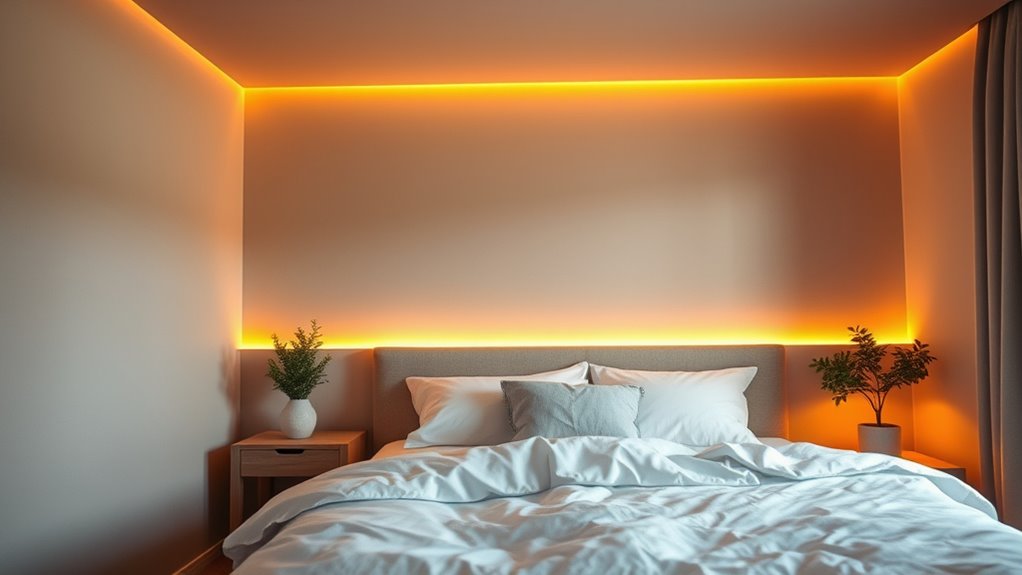To create a bedroom circadian lighting setup without blue overload, focus on using warmer, amber-toned lights in the evening around 2,700K to 3,000K to promote relaxation. During the day, opt for bright, cool-white or daylight bulbs to boost alertness. Use dimmable fixtures and smart lighting that gradually shift to warmer tones at night, helping your body naturally prepare for sleep. If you keep exploring, you’ll discover effective ways to optimize your sleep environment.
Key Takeaways
- Use warm, amber-colored lighting (around 2,700K) in the evening to support melatonin production and avoid blue light suppression.
- Install dimmable lights or bedside lamps to gradually reduce brightness before sleep, creating a calming environment.
- Opt for full-spectrum or daylight bulbs (4,000K–6,500K) during the day to promote alertness without excessive blue light.
- Employ blue light filters or glasses on screens in the evening to minimize blue exposure before bedtime.
- Utilize smart lighting systems that automatically shift to warmer tones as night approaches, aligning with circadian rhythms.

Creating the right lighting in your bedroom can considerably improve your sleep quality and overall well-being. When you choose lighting that aligns with your natural circadian rhythms, you set yourself up for more restful nights and energized mornings. One of the key factors to consider is light temperature. The warmth or coolness of your lighting can influence your body’s ability to produce melatonin, the hormone responsible for regulating sleep. Cooler, bluish light tends to suppress melatonin, making it harder to fall asleep, while warmer, amber tones promote relaxation and prepare your body for rest. By adjusting your light temperature throughout the day, you can mimic natural sunlight patterns and support your circadian health.
Adjust your bedroom lighting to harmonize with natural rhythms for better sleep and well-being.
In the evening, opt for lights with a lower color temperature, around 2,700K to 3,000K. These warmer tones create a cozy and calming environment, signaling to your brain that it’s time to wind down. Avoid bright, cool-white lights as bedtime approaches, because they contain higher levels of blue light that can interfere with your melatonin production. Instead, choose bedside lamps or dimmable fixtures that allow you to control the intensity and warmth of the light. This way, you can gradually reduce brightness and switch to softer, warmer lighting as you prepare for sleep.
During the day, exposure to brighter, cooler light—around 4,000K to 6,500K—can boost your alertness and help regulate your internal clock. If possible, let natural daylight fill your space in the morning and mid-afternoon, which reinforces your circadian rhythm. If natural light isn’t enough, use full-spectrum or daylight-mimicking bulbs that emit a balanced light temperature similar to the sun’s midday glow. These lights can improve your mood, focus, and overall sleep quality by keeping your biological clock in sync with the external environment.
Furthermore, understanding the importance of regulating light exposure can significantly impact your sleep hygiene and overall health. It’s also vital to avoid blue light overload in your bedroom, especially in the hours before bed. Limit screen time or use blue light filters on your devices, and consider installing smart lighting systems that automatically shift to warmer tones as evening approaches. This creates a soothing lighting environment that promotes melatonin release and helps you fall asleep faster. By carefully managing your light temperature and minimizing blue light exposure, you support your circadian health and enjoy more restorative sleep night after night.
Frequently Asked Questions
How Does Blue Light Affect Melatonin Production at Night?
Blue light suppresses melatonin production at night, disrupting your sleep cycle. When you’re exposed to blue light, especially from screens or artificial lighting, it mimics daylight and signals your brain to stay alert. This light pollution interferes with your body’s natural circadian rhythm, making it harder to fall asleep and wake up refreshed. Reducing blue light exposure in your bedroom helps restore melatonin levels and promotes healthier sleep.
Are There Specific Lighting Colors Best for Sleep Quality?
You should opt for warm lighting colors like red, amber, or soft orange, as they promote better sleep quality. These hues minimize blue light exposure, helping your melatonin production stay high overnight. By choosing lighting that mimics sunset tones, you signal your body it’s time to wind down, leading to more restful sleep. Avoid cool white or blue-toned lights before bed to guarantee ideal sleep quality and a relaxed, peaceful night.
Can Circadian Lighting Reduce Nighttime Awakenings?
Yes, circadian lighting can reduce your nighttime awakenings. By adjusting light intensity and color temperature, you create a more natural sleep environment. Softer, warmer light with lower intensity signals your body it’s time to wind down, helping you stay asleep longer. When you use lighting that mimics natural sunset tones, you support your circadian rhythm, which can lead to fewer nighttime awakenings and better overall sleep quality.
What Are the Health Risks of Blue Light Exposure Before Bed?
Blue light hazards can disrupt your circadian rhythm, making it harder to fall asleep and stay asleep. Studies show that exposure to blue light before bed can delay melatonin production by up to two hours. This disturbance increases risks for sleep disorders, eye strain, and even long-term health issues like obesity and heart disease. To protect your health, limit blue light exposure in the evening and use circadian-friendly lighting options.
How Can I Customize My Bedroom Lighting for Optimal Sleep?
You can customize your bedroom lighting for ideal sleep by using ambient dimming options that gradually soften the light as bedtime approaches. Incorporate warm, low-intensity bulbs to promote relaxation and mood enhancement without blue light overload. Avoid bright, blue-enriched lighting late at night, and consider smart lighting systems that adjust automatically. This setup helps signal your body to wind down, improving sleep quality and fostering a peaceful, restful environment.
Conclusion
By choosing circadian lighting that avoids blue overload, you’re setting yourself up for better sleep and overall well-being. Think of it as steering clear of rough waters; you’ll enjoy a calmer, more restful night. When you tune your bedroom lighting to match your natural rhythms, you create a sanctuary that nurtures your body’s internal clock. It’s a small change that can make a big difference, helping you wake up refreshed and ready to face the day.









